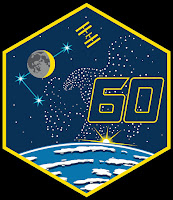ISS - Expedition 60 Mission patch.
Sept. 16, 2019
Some of the recent scientific studies conducted on the International Space Station looked at how humans adapt to life in space and the use of DNA and RNA sequencing of microbes. The Japan Aerospace Exploration Agency (JAXA) scrubbed the scheduled Sept. 10 launch of its cargo ship H-II Transfer Vehicle-8 (HTV-8) due to a fire on or near the launch pad at Tanegashima Space Center. A relaunch date has not yet been determined. The space station provides a platform for long-duration research on how living in microgravity affects the human body and testing technologies for traveling farther into deep space, which supports Artemis, NASA’s plans to go forward to the Moon and on to Mars.
Image above: Expedition 60 members, including European Space Agency (ESA) astronaut Luca Parmitano and NASA astronauts Christina Koch, Andrew Morgan and Nick Hague, gather in the space station’s cupola to take photographs of Earth. Image Credit: NASA.
Here are details on some of the science conducted by the Expedition 60 crew on the orbiting laboratory during the week of Sept. 9:
Documenting human spaceflight response before, during, and after flight
Standard Measures captures a consistent set of measures from crew members to characterize how their bodies adapt to living in space. The aim is to create a database of measures from all crew members in the International Space Station Program. The data enable high-level monitoring of the effectiveness of countermeasures and meaningful interpretation of health and performance outcomes, while supporting future research on planetary missions. Crew members conducted surveys and tests and collected samples for this investigation.
Sequencing Microbial DNA in Space
Animation above: NASA astronaut Christina Koch transfers samples for the BEST investigation, which identifies microbes collected from different locations in the space station and identifies them using DNA sequencing. Animation Credit: NASA.
The BEST investigation studies the use of DNA sequencing to identify unknown microbial organisms and to understand how humans, plants and microbes adapt to living in space. Crew members isolate microbes from various locations and identify them using a swab-to-sequencer process that does not require cultivation of the organisms. Additional experiment objectives include comparing mutation rates of bacteria grown on Earth and in space and demonstrating that it is possible to sequence ribonucleic acid (RNA) isolated from any organism directly. This work uses the Biomolecule Sequencer and Genes in Space hardware already on the space station. The crew transferred samples for the investigation to new media.
Measuring Crew Neutron Radiation Exposure
The crew retrieved the eight dosimeter bubble detectors for the RADI-N2 investigation from the Russian crew and deployed them in Node 1, which is connected to the U.S. Lab module. This Canadian Space Agency investigation characterizes the neutron radiation environment aboard the space station to help define the risk to the health of crew members and provide data for development of advanced protective measures for future spaceflight. Neutrons make up 10 to 30 percent of the biologically effective radiation exposure in low-Earth orbit. The bubble detectors detect only neutrons, ignoring all other types of radiation.
Capturing Life Aboard the ISS on Film
Crew members recorded footage of several activities this week for The ISS Experience, which creates virtual reality videos covering crew life, execution of science and the international partnerships involved on the space station. The videos educate a variety of audiences about space station life and research and could inspire additional microgravity research to benefit people on Earth and future space missions. The crew films less than four hours of footage each week and every few weeks transfers this footage onto solid-state drives for storage and downlinking.
Other investigations on which the crew performed work:
- Fluid Shifts measures how much fluid shifts from the lower to the upper body and in or out of cells and blood vessels in microgravity in an effort to determine how these shifts affect fluid pressure in the head, vision and eye structures.
https://www.nasa.gov/mission_pages/station/research/experiments/explorer/Investigation.html?#id=1126
- Space Moss determines how microgravity affects the growth, development and other features of moss. Tiny plants without roots, mosses need only a small area for growth, an advantage for their potential use in space and future bases on the Moon or Mars.
https://www.nasa.gov/mission_pages/station/research/experiments/explorer/Investigation.html?#id=7892
- Rodent Research-17 (RR-17) uses young and old mice to evaluate the physiological, cellular and molecular effects of microgravity and spaceflight.
https://www.nasa.gov/mission_pages/station/research/experiments/explorer/Investigation.html?#id=7992
- The Micro-15 investigation examines the mechanisms behind observations that microgravity affects gene expression and stem cell differentiation and proliferation, using three-dimensional cultures of mammalian stem cells.
https://www.nasa.gov/mission_pages/station/research/experiments/explorer/Investigation.html?#id=7653
Image above: The Microgravity Crystals experiment leverages extensive protein crystallization work on the space station, significantly increasing the likelihood of successful growth. NASA astronaut Christina Koch observes and photographs samples grown for the investigation. Image Credit: NASA.
- The Microgravity Crystals investigation crystallizes a membrane protein that is integral to tumor growth and cancer survival.
https://www.nasa.gov/mission_pages/station/research/experiments/explorer/Investigation.html?#id=7977
- Food Acceptability examines changes in the appeal of food aboard the space station during long-duration missions. “Menu fatigue” from repeatedly consuming a limited choice of foods may contribute to the loss of body mass often experienced by crew members, potentially affecting astronaut health, especially as mission length increases.
https://www.nasa.gov/mission_pages/station/research/experiments/explorer/Investigation.html?#id=7562
- Probiotics studies whether beneficial bacteria, or probiotics, can improve the intestinal microbiota of crew members and help improve their immune function on long-duration space missions.
https://www.nasa.gov/mission_pages/station/research/experiments/explorer/Investigation.html?#id=2047
- UAE Palm Growth examines germination of palm tree seeds in order to determine the best conditions for generating tissue samples for research and observes and documents root growth in microgravity for educational purposes.
https://www.nasa.gov/mission_pages/station/research/experiments/explorer/Investigation.html?#id=8080
Space to Ground: Counting Down: 09/13/2019
Related links:
Expedition 60: https://www.nasa.gov/mission_pages/station/expeditions/expedition60/index.html
H-II Transfer Vehicle-8 (HTV-8): https://www.nasa.gov/mission_pages/station/structure/elements/htv.html
Standard Measures: https://www.nasa.gov/mission_pages/station/research/experiments/explorer/Investigation.html?#id=7711
BEST: https://www.nasa.gov/mission_pages/station/research/experiments/explorer/Investigation.html?#id=7687
RADI-N2: https://www.nasa.gov/mission_pages/station/research/experiments/explorer/Investigation.html?#id=874
The ISS Experience: https://www.nasa.gov/mission_pages/station/research/experiments/explorer/Investigation.html?#id=7877
Spot the Station: https://spotthestation.nasa.gov/
Space Station Research and Technology: https://www.nasa.gov/mission_pages/station/research/index.html
International Space Station (ISS): https://www.nasa.gov/mission_pages/station/main/index.html
Images (mentioned), Animation (mentioned), Video (NASA), Text, Credits: NASA/Michael Johnson/Vic Cooley, Lead Increment Scientist Expedition 60.
Greetings, Orbiter.ch




